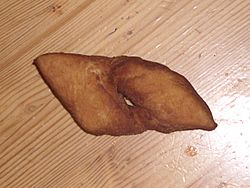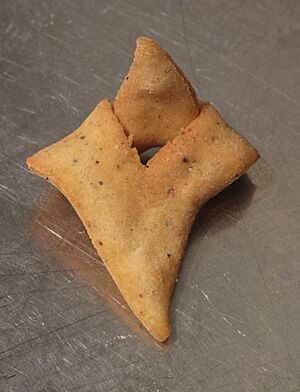Klenät facts for kids
 |
|
| Alternative names | Klena, Klejne, Kleina, Kleyna, Fattigmann |
|---|---|
| Type | Doughnut |
| Region or state | Northern Europe |
| Main ingredients | Flour, egg yolks, sugar, margarine or butter |
Klenät (also called kleinur, klena, klejne, kleina, kleyna, and fattigmann) is a tasty pastry that is deep-fried. It's a bit like angel wings or a doughnut. You can find this sweet treat in many places. It's very popular in countries like Sweden, Iceland, and Norway. You can also find it in other parts of Europe and the United States.
The name "klenät" comes from a Swedish word meaning "slender." This might suggest the pastry originally came from Germany. Klenät is made from flattened dough. This dough is cut into small shapes, usually trapezoids. Then, a cut is made in the middle. One or both ends of the dough are pulled through this cut to make a special "knot" shape. After shaping, the klenät is deep-fried in hot oil or fat until it's golden brown. Sometimes, people sprinkle it with powdered sugar and cinnamon for extra flavor.
In Scandinavia, klenäter are a traditional Christmas treat. They are especially common in southern Sweden, Iceland, Norway, the Faroe Islands, Greenland, Denmark, and the Baltic states. You can also find them in Northern Germany. In Iceland, Kleinur are eaten all the time, not just at Christmas. Bakeries sell them one by one, and stores sell them in bags. They are usually eaten plain there. Klenäter are similar to a pastry called a cruller in America.
History of Klenät
Klenäter are a very old type of pastry. People have been enjoying them for a long time. They were first mentioned in Denmark as early as the 14th century. That's over 600 years ago! You can find recipes for klenäter in Danish and Icelandic cookbooks from the 18th and 19th centuries.
This pastry also appears in old stories and poems. A famous Swedish poet, Anna Maria Lenngren, wrote about klenäter in her poem Grevinnans besök (The Countess' Visit) in 1800. In the poem, a countess is served klenäter at a dinner party. Klenäter are also often mentioned in Christmas stories by the famous Swedish author Selma Lagerlöf. She won the Nobel Prize in Literature in 1909.
Regional Klenät Styles

Klenäter have different names and slight variations depending on where you are.
In Norway, klenäter are known as fattigmann. This means "poor man." They are also called fattigmannsbakkels, which means "poor man's pastry." People used to say that making these cookies was so expensive it could make you poor! Norwegian fattigmann often include cinnamon, cardamom, and a little bit of cognac along with the usual ingredients.
This pastry is also eaten in parts of North America. Many Scandinavians moved there in the 1800s and early 1900s. They brought their traditions, including klenäter, with them.
There's a similar pastry in Chile called "calzones rotos." It's eaten during the winter months there.
How to Make Klenät
To make klenäter, you start with a dough made from flour, egg yolks, sugar, and margarine or butter. The dough is rolled out flat. Then, it's cut into strips. In Iceland, people often use a special cutting wheel called a kleinujárn. You can also use a pizza cutter!
The strips are usually about 10 centimeters (4 inches) long. After cutting, the uncooked strips are covered with plastic wrap. They need to rest in a cold place for about two hours. Then, they are ready to be fried. They are deep-fried in oil. Sometimes, people use lard instead. As the dough fries, it expands into its unique knot shape. Traditionally, Icelanders fried kleinur in sheep tallow. Today, however, oil is more commonly used.
Some recipes add extra ingredients for flavor. These can include lemon juice, a type of alcohol called brännvin, or cognac. You can also use water mixed with acetic acid as an alternative. Another type of klenäter is called smördegsklenätter. These are made with puff pastry.
Klenäter should be stored in a dry place. The dough that hasn't been fried yet can be kept in the refrigerator for up to a week. Klenäter taste best when they are served warm and freshly baked.
See also
 In Spanish: Klenät para niños
In Spanish: Klenät para niños


